Restorative yoga is a gentle, calming practice. It emphasizes relaxation and mindfulness. It’s a great way to reduce stress and anxiety. It focuses on long, passive stretches, supported by props like blankets and bolsters. This allows your body and mind to relax and release tension. Here are some tips on how to use restorative yoga for stress and anxiety relief:
1. Create a Calm Environment
- Set the Mood: Dim the lights or light some candles. Use soothing scents like lavender or sandalwood to create a calming atmosphere.
- Play Soft Music: Nature sounds or gentle instrumental music can enhance relaxation.
2. Focus on the Breath
- Practice Deep Breathing: Inhale deeply through the nose. Exhale slowly through the mouth. Diaphragmatic breathing stimulates the parasympathetic nervous system, which helps reduce stress.
- Mindful Breathing: Sync your breath with your movements. Or, hold poses while focusing on the rhythm of your breath. This helps quiet the mind and center your focus.
3. Choose Relaxing Poses
Restorative yoga involves holding poses for 5-10 minutes. This allows your body to relax fully. Here are some poses that are particularly good for stress relief:
- Child’s Pose (Balasana): A grounding pose that soothes the mind and stretches the back.
- Supported Bridge Pose (Setu Bandhasana): Opens the chest and calms the nervous system.
- Reclined Bound Angle Pose (Supta Baddha Konasana): Opens the hips and relieves tension in the lower body.
- Legs Up the Wall Pose (Viparita Karani): A great pose. It reduces anxiety and boosts circulation.
- Corpse Pose (Savasana): The ultimate relaxation pose. It allows for deep rest, both mental and physical.
4. Use Props for Support
Restorative yoga often uses props to support your body. This lets you rest fully into each pose.
- Bolsters or Pillows: Provide support under your knees, back, or neck.
- Blankets: Add extra comfort or warmth to help you feel more secure and relaxed.
- Blocks: Help adjust your alignment and bring the floor closer to you in seated or lying poses.
5. Mindfulness and Meditation
- Body Scan Meditation: In each pose, mentally scan your body from head to toe. Notice where you hold tension. Then, relax those areas.
- Mantra Repetition: Silently repeat a calming phrase, like “I am at peace,” to keep your mind focused and relaxed.
6. Lengthen Your Practice
Restorative yoga isn’t about rushing. Allow yourself 30-60 minutes to settle into the practice. Spend several minutes in each pose, letting your body and mind fully unwind.
7. Stay Present
- Practice Non-Judgment: Restorative yoga encourages you to let go of expectations. Don’t judge yourself if your mind wanders or if it takes time to relax.
- Observe Your Emotions: Don’t push away anxious thoughts or stress. Acknowledge them. Then, let them pass without attachment.
8. Consistency is Key
For long-term benefits, try doing restorative yoga 2-3 times a week. Even a short session can make a significant difference over time.
9. End with Gratitude
At the end of your practice, take a moment to express gratitude. Gratitude helps you shift from stress to positivity. It does this for your body, your breath, and your time.
You can create a powerful practice to manage stress and anxiety. Combine restorative yoga’s gentle, supportive movements with mindful breathing and meditation. The key is to allow your body and mind the space to relax and restore.

